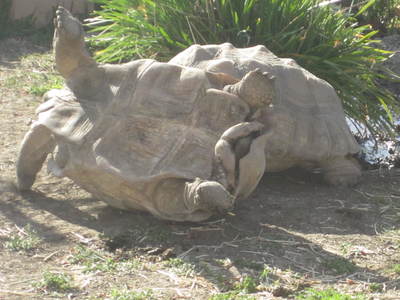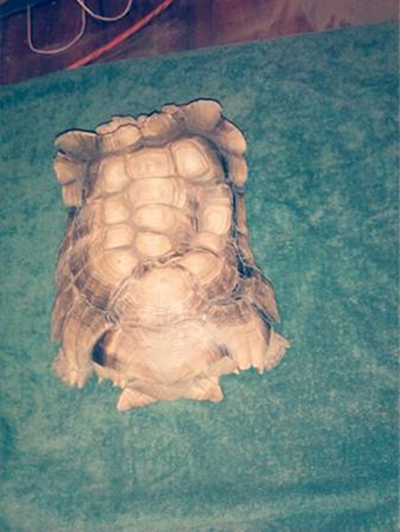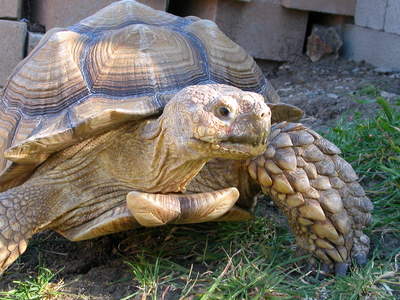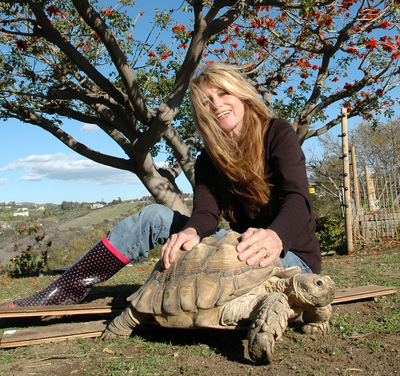 African Tortoises Have Very Special Needs The African Spurred known as a sulcata is a herbivorous tortoise, thus a high fiber intake of grasses, hay, weeds or roughage should form the bulk of its diet. Wild tortoise feces are generally well compacted, well formed, and very high in varied grass content. In captivity a variety of vegetables and some fruit can be offered. Although sulcata will eat animal protein, it should be avoided as it will cause carapace deformity. It should be noted that excessive quantities of beans, bean sprouts, peas and similar rich protein rich vegetables can lead to scute pyramiding. An overall high protein diet will cause rapid growth, kidney failure and a shortened life span. Other cautions are excessive goitrogenic vegetables such as broccoli, brussel sprouts, kale and varieties of cabbage which can lead to goiter and hypothyroidism. Feeding too many greens high in calcium oxalate such as parsley, spinach, collards and carrots can bind calcium which could lead to disfiguring and deadly metabolic bone disease (pictured at the end). The mixed green-leaf vegetable base should comprise > 90% of the dietwhich includes course mixed grasses such as grass hay (lower in protein), sow thistle, clover, dandelion, edible flowers, dark green lettuce such as romaine, (no iceberg), escarole, endive, chard, squash, pumpkin, corn, and turnip greens. Cactus paddles are great as are prickly pears (the fruit). A lack of dietary fiber or roughage will lead to diarrhea as will feeding fruit which should be avoided. Cucumber, zucchini, red and green sweet peppers may also be included. Try to provide a wide range of suitable foods as possible, avoiding too much of the right type or staple food as tortoises can become addicted. To summarize, the ideal diet for herbivorous tortoises should be: Water should be available at all times either in clay saucers or metal backing pans. For the first year sulcatas should be fed daily,thereafter 3 times weekly.Remembering this tortoise comes from the sub-Sahara where habitat is semi-desert and where food is not always plentiful. Overfeeding these enormous eaters in captivity will cause problems. Health A healthy tortoise will have good weight, muscular vigor, and a good withdrawal response when a hind limb is gently pulled. The eyes should be wide open when awake, slightly rounded cheeks, and a bilaterally symmetrical head. The vent area or cloaca at the base of the tail should be flush, not swollen or crusty and without smears of watery feces. If a tortoise appears healthy but has watery feces it could be a sign of a parasitic disease and should be checked and treated. A nasal discharge and watery eyes may be a sign of a respiratory infection. Gaping and forced exhalation are common symptoms of pneumonia. Such cases require antibiotic therapy, warmer temperatures and possible hand feeding in the case of lethargic or anorexic animals. Breeding Don’t!!!!!!! We do not recommend breeding as there is an enormous number of sulcatas for adoption. Sulcatas are prolific breeders in captivity with males reaching sexual maturity at about 14 inches (35 cm.). Aggressive behavior may take place with repeated ramming by the males sometimes ending up in bloody limbs and heads. In southern California breeding usually occurs during hot days and months of the year with egg-laying occurring during the following late winter or spring. This is a good time to say stick with one sulcata – they fight, breed and overall destroy the environment as they get bigger. One is enough and they won’t get lonely. Trust us. Hatchlings Hatchlings measure approximately 45-50 mm long, weigh between 25-30 grams, and are a uniform pale yellow-ivory color. However, much darker examples may be encountered. The scutes have narrow brown borders with a serrated periphery of the carapace. When housing hatchlings, the enclosure must have a warm side and a cool side for thermoregulation with a provision for UVB producing fluorescent lights. Temperatures are much the same as explained earlier or slightly on the warmer side. Growing tortoises, when not provided with enough heat and fed excessive calcium, vitamin D3, and or protein, may develop deformed shells. This disproportionate growth may be linked to protein availability in relation to calciumand D3, but temperature is now considered a critical factor in this syndrome. Offering a balanced diet and providing a heat source are main factors for successfully raising healthy tortoises. Diet is similar to that of adults. Chop the food into bite-size pieces, approximately the size of the head. Clean water should be made available at all times. Young individuals shouldbe soaked at least once a week for 15 minutes in a shallow bath of warm water to prevent dehydration. This will also encourage the elimination of waste products. Sulcatas come from some of the Sahel, the hottest, driest area in Africa. Some regions may not get rain for years. To make the most of available moisture, their skin is resistant to fluid loss but, when exposed to moisture, may become highly permeable. Towards this end, they will excavate pallets or burrows in the ground to get to areas with higher moisture levels; in the wild, they may spend the hottest part of the day in these microhabitats. Burrows may average 30 inches in depth; some dig tunnel systems extending 10 feet or more underground. Sulcatas are, like most turtles and tortoises native to dry areas, extremely efficient in their use of water. A sulcata may urinate just 0.64 ml a day, significantly less than their spur-thighed cousins living in the relatively lush Mediterranean countries who may urinate 1-2 ml a day. A danger, then, in captivity is that too much water may be given or made accessible which may lead to health problems including skin and shell infections and kidney problems. In captivity, a similarly hot and dry environment must be provided year round. Unlike the California desert tortoises, the sulcatas do not hibernate. While they can tolerate some surprisingly low temperatures, they cannot be allowed to get both chilled and wet or kept outdoors in chill, damp weather. Housing Daytime temperatures during much of the year should range from 85-105 F (29-40 C) during the day. At night, temperatures can drop into the 70s F (21-26 C) in their enclosure. They must be dry. Provisions must be made to house them safely during rainy weather and in places where the nights are cold and/or damp. Outdoors Sulcatas can be housed outdoors only if they are provided dry, heated housing into which they will retire at night and during inclement weather. If they will not come out and go in on their own, they will have to be directed or physically moved. (Note that while this may not be a problem when the tortoises weigh less than 25 pounds or so, it can become quite problematic when they weigh 90 pounds or more.) In sufficiently dry areas that are protected from predators and humans, sulcatas may be kept outdoors at night as well, with living in-ground trees and shrubs providing the shelter over their pallets they require. We recommend that fencing surrounding the compound be solid – several layers of concrete blocks do the trick: if the sulcatas can see through it, they will try to plow through or burrow under it. A dog house or one you build yourself (see picture below) make suitable houses for sulcatas. They must be raised up off the ground and must be supplied with heat during colder weather. A wide ramp must be constructed for them to move easily in and out. Make a wood door that slides off to cover the opening. It will also help insulate the house by reducing heat loss. During the winter months, we use radiant heat panels screwed into the roof as overhead heat suspended from the ceiling of the house and safely out of reach of the tortoise. One or more Kane heat pads or pig blankets - rigid heating pads made for pigs to lie upon - can be used inside on the floor. Both of these heating elements can be purchased from www.beanfarm.com . Neither heat lamps or ceramic lamps should ever be used as they cause fires easily and since this happens frequently, we insist that you never consider them. A shallow water bowl – we use a large aluminum baking pan from a kitchen store - , with sides low enough for the tortoise to reach into, should be available at all times if there is no wallow available. Tortoises do not swim, they sink. You need to make sure they can easily access the water but that it is not any deeper than the tortoise's bridge, the section of shell that joins the carapace (top shell) and plastron (bottom shell). A bowl or flowerpot saucer (plastic or glazed ceramic) may be fine for a larger tortoise; it may need to be sunk slightly into the substrate for smaller tortoises. Be prepared to refresh daily and clean frequently. A note on predators and other harmful species Animals such as raccoons or coyotes may prey upon sleeping tortoises. Dogs may harm tortoises just by being inquisitive or playful...small tortoises look, smell and taste too enticing to not be a chew toy! Tortoises kept in front and easily accessible side yards are enticing to unscrupulous members of a two legged species: many tortoises have been spirited out of their yards by humans. Make sure all fencing is secure, both to prevent the tortoise from barging through it or digging under it, and to prevent unwanted visitors from coming in or accidentally letting them out. We use electric fencing throughout the rescue. Indoors Given the tremendous amount of room these tortoises need to roam, maintaining them inside year round is not advised. Temporary indoor housing, as for hatchlings (see section on hatchlings below), sick individuals or during inclement weather, can be set up. Such indoor housing must include both basking and cooler retreat areas, and a den box or trash can on its side in which to burrow. An area for feeding and a shallow water dish must also be provided. Ultraviolet B lighting must be provided as well as suitable temperature ranges during both the day (80 F (27 C) with a basking area (100 F (39C)) and turn off all lights at night but keep temps at (72 F (22 C)). Behavior Sulcatas like to move around and are very strong -- they must have a large area in which to freely and widely roam. Sulcatas also need to burrow away from the heat and do so by retreating to their pallets or into muddy wallows where they will stay for hours, flipping cool mud up onto their backs. When temperatures exceed 104 F (40 C), they will begin to salivate heavily, smearing the saliva on their forearms to help cool themselves down. Whether housed indoors or out, Sulcatas roam about and are voracious eaters. Like many tortoises, they are also climbers. Care must be taken to assure they are not given the opportunity to climb things that are too steep resulting in their toppling over. If they flip onto their backs and are not able to right themselves, they may die of hyperthermia if they do it during the hottest part of the day. They may also choke or drown on their own vomit if they panic. They may lose precious water by voiding urates and thus become seriously dehydrated. Suffocation is also a possibility if they are left upside down too long as their lungs, which are near the top of their carapace, are compressed by the weight of their internal organs. Keep dangerous objects out of their area. Steps, dogs, raccoons and children are among some of the dangers that must be guarded against. So too human and animal hair, pesticides and herbicides, small plastic, glass and metal toys, and toxic plants. Sulcatas are voracious, if not always smart, eaters and will ingest anything small enough and colorful enough. That includes painted toenails. Provide variety and security. Provide a cluster of sturdy, low growing plants they can crowd in amongst. Provide an interesting terrain by leaving (or building) some low hummocks, smooth rocks, pieces of wood, clumps of weeds and edible plants. Below is the house we built for our sulcatas. It is fireproof and almost indestructible. We built a cinderblock and rebar house with a removable roof for cleaning and a removable door for closing as well as a wind barrier. The roof has a radiant heat panel screwed into the underside for heat from above and the floor is made up of pig blankets (made for pigs so they can take the weight) called Kane heat pads – both are available from www.beanfarm.com . Never use any lights – they cause fires. Never cover the pig blankets with any substrate or hay. Check out this Buzzfeed article – https://www.buzzfeed.com/catferguson/a-reptile-dysfunction?utm_term=.wlK66wDRwr#.vr800DxaDG – tells it like it is. About Us American Tortoise Rescue is a nonprofit founded in 1990 for the protection of all species of turtles and tortoises. We have rescued more than 4,000 since our inception. Foundlings that cannot be adopted because of ill health remain in the care of ATR for the remainder of their lives. Celebrate World Turtle Day every year on May 23rd! Contacts american tortoise rescue, 30745 PCH, #243 Malibu, CA 90265 http://www.tortoise.com [email protected] www.worldturtleday.org  American Tortoise Rescue (ATR), a nonprofit organization established in 1990 for the protection of all species of tortoise and turtle, is celebrating its 16th annual World Turtle Day® on May 23rd. The day was created by ATR to celebrate and protect turtles and tortoises and their disappearing habitats around the world. Now celebrated around the globe, turtle and tortoise lovers are taking “shellfies” and holding “shellebrations” in the US, Canada, Pakistan, Borneo, India, Australia, the UK and many other countries. ATR launched World Turtle Day to increase respect and knowledge for the world’s oldest creatures. These gentle animals have been around for 200 million years, yet they are rapidly disappearing as a result of smuggling, the exotic food industry, habitat destruction, global warming and the cruel pet trade. It is a very sad time for turtles and tortoises of the world. (See slide show here.) Biologists and other experts predict the disappearance of turtles and tortoises within the next 50 years. Adults and children can do a few small things that can help save turtles and tortoises for future generations.
ATR’s ultimate goal is to stop the illegal trade in turtles and tortoises around the world. The first priority here in the U.S. is to ask pet stores and reptile shows to stop the sale of hatchling tortoises and turtles without proper information for the buyer. For example, many people buy sulcata tortoises as an impulse buy because they are so adorable when they are tiny. The breeders and pet stores frequently do not tell the buyers that this tortoise can grow to 100 pounds or more and needs constant heat throughout the year since they do not hibernate. ATR also educates people and schools about the real risk of contracting salmonella from water turtles. Wash hands thoroughly every time you touch a turtle or its water, and do not bring turtles into schools or homes where children are under the age of 12. Some of the highlights to make World Turtle Day special, include:
Please note: World Turtle Day ® is trademarked – please use registered symbol. About Us American Tortoise Rescue is a nonprofit founded in 1990 for the protection of all species of turtles and tortoises. We have rescued more than 4,000 since inception. Foundlings that cannot be adopted because of ill health remain in the care of ATR for the remainder of their lives. ATR acts as a clearinghouse for information about turtle care. We work to abolish “live market” slaughter of turtles in the US, the sale of reptiles on sites like Craig’s List and the cruel importation and exploitation of a variety of species. Celebrate World Turtle Day every year on May 23rd! Contact american tortoise rescue 30745 PCH, #243 Malibu, CA 90265 [email protected] www.worldturtleday.org http://www.tortoise.com Facebook: American Tortoise Rescue and World Turtle Day Twitter @tortoiserescue YouTube: AmericanTortRescue Instagram: TortoiseRescue Tweet these tweets #Shellebrate and protect turtles and tortoises and their disappearing habitats around the world #shellebrate #worldturtleday Free #WorldTurtleDay Party Pack here http://bit.ly/1YwebJR |
Please post an email with your comment or email [email protected] if you want a personal answer for a blog question! Archives
November 2023
Categories
All
|







 RSS Feed
RSS Feed